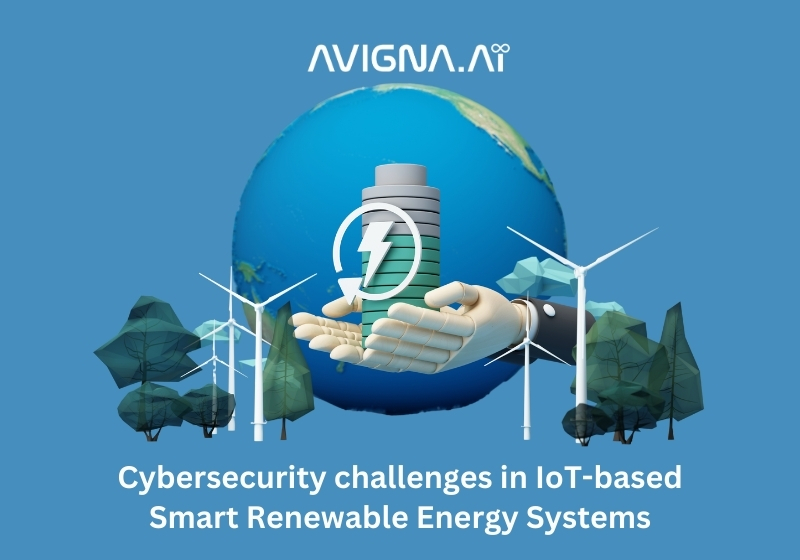Cybersecurity challenges in IoT-based Smart Renewable Energy Systems
IoT is enhancing the performance, dependability and applications of renewable energy globally. Solar and wind farms employ weather monitoring sensors to assess the possible energy generation to assess the possible generation of energy.
For example, wind turbines control and vary the angles between the blades as per the external wind information. Solar panel tracker systems turn the solar panels towards the sun to increase the sunlight property absorption. When conditions change, energy storage intervenes to ensure there is always a power supply during peak hours.
Smart renewable energy systems facilitate communication technologies, creating a hierarchical structure with energy producers, distributors, and consumers at the lowest level. This is coordinated through control centres by real-time IoT technology applications, which envisages a cleaner and steadier energy source.
An Open Door for Hackers
However, despite such merits, there is connectively posed threat to the system itself. The infrastructure that makes using renewable resources through smart technologies possible is vulnerable to cyber intrusions. Hackers may remotely infiltrate systems to steal sensitive operational data, disrupt energy distribution, or even damage expensive equipment.
With IoT-based smart renewable energy systems often located in remote areas, physical access for repairs or incident response becomes challenging. Meanwhile, many smaller renewable operators need more in-house cybersecurity expertise.
Many examples of distressing attacks in the past years demonstrate that those risks are by no means hypothetical. In the latter half of 2015, a group of cybercriminals remotely connected to power grid systems and changed the operation of circuit breakers through insecure VPNs, causing blackouts in parts of Ukraine.
For instance, cyber attackers hacked and interfered with the supervisory systems of operations of some of Germany’s largest municipal energy providers. These successful attacks showed that service disruptions and cascading effects are not an exaggeration where ICS mingle with open networks, and the threat is real.
Cyber threat mitigations for smart renewable systems are crucial to the protection of energy security, people, and the continuity of operations of businesses. But where exactly are these vulnerabilities, and how can they be addressed?

Key Vulnerabilities and Threats
After reviewing different studies on this topic, several common vulnerabilities and threats facing IoT-based renewable systems emerge:
Insecure Protocols and Poor Encryption: Many SCADA and industrial control protocols, such as Modbus, do not have defensive cyber capabilities. The lack of authorization, authentication, and encryption makes the data vulnerable.
Lack of Access Control: It is easier for attackers to stealthily penetrate the networks in the absence of limitations concerning the users and devices that are allowed access.
Insecure Device Defaults: Devices registered for IoT applications usually have pre-configured passwords that are not changed, intruding most performant.
False Data Injection: Attackers can destroy or alter sensors and their readings to obtain crucial operational information and trick control systems into making dangerous, arbitrarily wrong decisions.
Man-in-the-Middle Attacks: Hackers can tap into the communication channel of devices and modify the messages being sent between the devices without either ‘spoofing’ or ‘eavesdropping’ in a nefarious manner.
Denial-of-Service: Traffic flood attacks can incapacitate networks or systems and disrupt necessary operations or services by exceeding capacity.
Impacts of these threats may include forgone revenues, damage to asset facilities and, worst of all, endangering public health. Therefore, in which ways can these cyber vulnerabilities be minimized?
A Blueprint for Cyber Resilience
Below are some actionable and evidence-based recommendations for improving cybersecurity in renewable systems:
Standardize Protocols and Encrypt All Communications
Implement open authentication interfaces like TLS to run industrial control systems and enforce encryption policies on the data in motion over each network element, including system authentication and authorization.
Adopt Principles of “Security by Design”
Instead of introducing cyber security measures as a last resort, cyber security should be instilled as an integral part of the planning, designing, acquiring, and installing systems.
Limit Network Exposure and Segmentation
Control access to real-time control operational networks so that they are not interfaced with the corporate networks or even the internet physically or logically. Access permissions should be restricted on a need-to-know basis.
Patch and Update Systems Regularly
Put in place all the system components and remediate policies that will enable the systematic security management of all system components, their upgrades or installations, the changes in known vulnerabilities, and their remediations.
Monitor for Unauthorized Activity
Adopt an in-depth defence strategy employing firewalls, intrusion prevention, anomaly detection, and whitelisting to preemptively scan and detect any suspicious activity both on the network perimeter and within the network.
By confronting cyber risks proactively today, we invest in a smarter, more robust, more secure energy grid tomorrow, powering economies on cleaner, renewable sources. The green technology revolution depends upon smart renewable energy systems.

Conclusion
While no silver bullet exists, with diligent multi-stakeholder cooperation guided by science-driven methodologies, we can be optimistic that the renewable sector can create an operationally, technically and culturally advanced security posture ready for whatever challenges that may emerge.
Our environment and citizens deserve energy supplies upheld by resilient, reliable and trustworthy infrastructure protected against disruption, whether through natural disasters or cyber incidents.
At Avigna, we hold extensive experience in building safe, secure IoT solutions for renewable energy. Contact us for a consultation to discover how we can safeguard your smart renewable energy systems.



